I’ve gone through various sleeping pads over the years. While I’ve found some comfortable inflatable sleeping pads for summer camping, I’ve also had some that just didn’t hold air. I got tired of waking up in the middle of the night with a rock jabbing me in the back. So, today I’m going to share my top picks for the best foam sleeping pads.
Article Overview
Why Choose One of the Best Foam Sleeping Pads?
The best foam sleeping pads are lightweight, durable, and more affordable than many inflatable or self-inflating pads out there. You won’t be worried about them getting punctured or leaking air, they can easily be carried on the outside of your pack without damage, and they also double as nice seats for a little added cushion around camp.
Top Picks for the Best Foam Sleeping Pads
Here are my top five foam sleeping pads:
Thermarest Z Lite Sol Foam Sleeping Pad
Z Lite Sol Sleeping Pad Overview
The ThermaRest Z Lite Sol is the best foam sleeping pad I’ve found for shorter backpacking adventures. It’s also one of the lightest and most compact closed-cell foam sleeping pads out there.
I like it because it doubles as a seat cushion when you’re sitting around the campfire or just taking a break for lunch. It’s an excellent choice for all those ultralight backpackers out there because of the accordion style in which it packs up and because of its lightweight (just 10 ounces for the small version and 14 ounces for the regular model.
Z Lite Sol Specs
REGULAR
Dimensions: 72″ x 20″ x 0.75″
Weight: 14 ounces
Packed Size: 20″ x 5″ x 5.5″
SMALL
Dimensions: 51″ x 20″ x 0.75″
Weight: 10 ounces
Packed Size: 20″ x 4″ x 5.5″
Z Lite Sol Features
The Thermarest Z Lite Sol is made with molded, closed-cell foam and filled with cross-linked polyethylene. It boasts an R-value of 2.6, which makes it a credible three-season foam sleeping pad option.
One of the biggest reasons why I’ve enjoyed the Thermarest Z-Lite is its durability. I’ve had it for over three years now and (for the price) it has been one of the most comfortable mattresses I’ve ever used.
It also features a ThermaCapture surface that helps to reflect radiant heat back to your body and amplifies the warmth of its heat-trapping dimples by a full 20%. The foam is also designed to be denser on the bottom to make it more durable to wear and tear.
Pro Tip On This Sleeping Pad
I put the Z-Lite INSIDE of my backcountry bed, regardless of whether I’m spending the night in a tent or in a hammock. By doing so (and sleeping nearly naked most of the time), I’m able to maximize the pad’s heat-reflective capabilities to stay warm on even the coldest of nights.
Thermarest Ridgerest Classic Foam Sleeping Pad
Ridgerest Sleeping Pad Overview
The Ridgerest Classic is a revival of Therm-a-Rest’s original foam sleeping pad. I picked up the Ridgerest back in the day as my first-ever sleeping pad. I remember it being a little thinner than my current Z-Lite, but it still very much got the job done.
And its ability to roll up can work better for certain external frame packs than a foldable pad would. If you’re simply looking for an affordable, basic level of backpacking comfort, it’s hard to pass up the Ridgerest Classic.
Ridgerest Specs
REGULAR
Dimensions: 72″ x 20″ x 0.63″
Weight: 14 ounces
Packed Size: 20″ x 8″
LARGE
Dimensions: 77″ x 25″ x 0.63″
Weight: 19 ounces
Packed Size: 25″ x 8.5″
Both versions offer an R-value of 2.6, making them great for three-season use.
Ridgerest Features
The best feature of the Ridgerest Classic is that it’s virtually indestructible. You don’t have to worry about excessively clearing your sleeping spot before lying your pad down because you’re worried about a rock popping an inflatable pad.
With the Ridgerest, there’s never any concern about its durability. Additionally, the Ridgerest Classic has a unique design. It has supportive peaks and heat-trapping valleys that provide ample comfort and also keep heat from leaving your sleeping area.
Pro Tip On This Sleeping Pad
Because it has been several years since I used a Ridgerest, I went through some user reviews to scour for pro tips. And, what do you know, I found a gem. This one comes to you from ‘Keepsmoving’ in Colbert, GA:
“I thru-hiked the A.T. in 2012 and used my Ridgerest the whole way. It was great to just throw it in my tent and crash at the end of a day’s hike. Not to mention no chance of getting a hole in it from snags along the trail. I lost so much weight on my trek that the hip belt on my pack became useless. A fellow hiker gave me the idea to cut 3″ off my Ridgerest, slide it into an old pair of socks then sew this to the belt. Worked like a charm.”
NEMO Switchback Foam Sleeping Pad
Switchback Sleeping Pad Overview
NEMO is a company that has just recently come onto the scene in the outdoor gear industry. The NEMO Switchback is their version of the Z-Lite sleeping pad from Therm-a-Rest.
It’s made of closed-cell foam and finished with a low-emissivity film to add a layer of warmth. It’s competitive in terms of price with the Z-Lite and provides another great option for ultralight backpackers.
Switchback Specs
REGULAR
Dimensions: 72″ x 20″ x 0.9″
Weight: 14.5 ounces
Packed Size: 20″ x 5″ x 5.5″
SHORT
Dimensions: 51″ x 20″ x 0.9″
Weight: 10.5 ounces
Packed Size: 20″ x 5″ x 4″
Switchback Features
The makers of the Switchback designed its hexagonal patterning to make it easier to pack and attach to your pack. But that patterning also makes it feel more plush and comfortable when unfolded.
The pad features hypnoelastic zones that conform to your body to give it more support and make you that much more comfortable when you lay down to nod off to sleep. That metallic, low-emissivity film we mentioned earlier also reflects more heat back to your body to keep you warm throughout the night.
Pro Tip On This Sleeping Pad
Again, because I’m lacking in personal experience with the NEMO Switchback (although I’d imagine you can use it inside your sleeping bag or backcountry bed, much like I do with my Z-Lite), I’ve scoured the Internet for reviews to bring you this pro tip. This one comes to you from ‘IowaHiker33’:
“Super compact, easy to fold, and very comfortable. Perfect for car camping or anything cold-weather that requires insulation. Ability to stack means more room for the important stuff (beer!).”
Big Agnes TwisterCane BioFoam Sleeping Pad
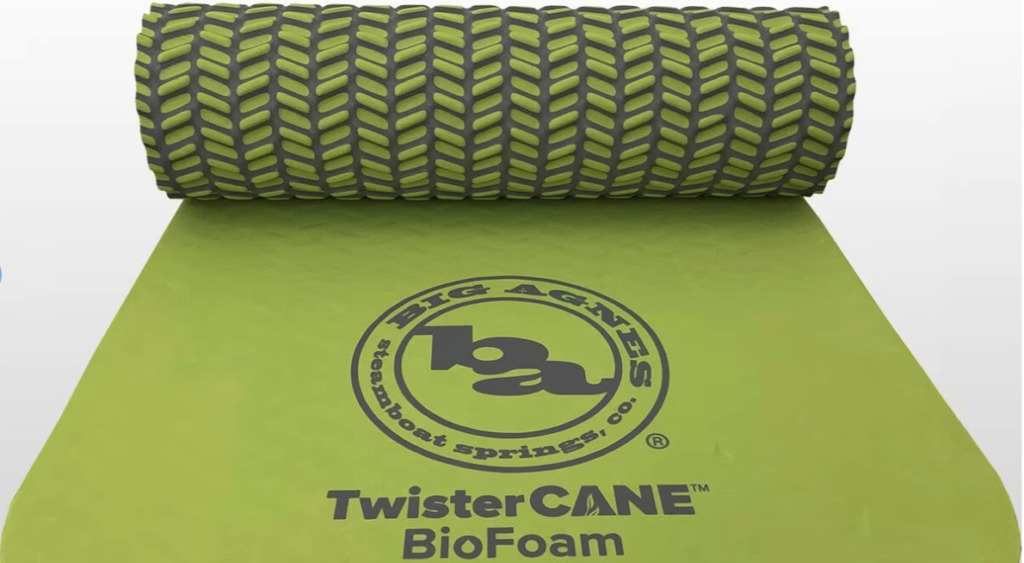
TwisterCane BioFoam Sleeping Pad Overview
The Big Agnes TwisterCane BioFoam Sleeping Pad is one of the best foam sleeping pads to pair with an inflatable pad to provide extra insulation from the cold ground.
Or, it can be used on its own. It’s a roll-up style pad with a 1.7 R-value that easily packs on the exterior of your pack when not in use and is suitable for anything from multi-day backpacking trips to weekend car camping getaways.
TwisterCane BioFoam Specs
REGULAR
Dimensions: 72″ x 20″ x 0.5″
Weight: 14 ounces
Packed Size: 7″ x 20″
TwisterCane BioFoam Features
This Big Agnes sleeping pad is made with closed-cell EVA foam that’s made with more than 60% sustainably grown sugarcane resin. designed to give you a firm and well-insulated barrier between your body and the cold, hard ground.
The pad is engineered with two foam layers (a top and bottom) that offer added warmth and comfort. It features die-cut sections and heat-trapping valleys on its top layers that trap warm air to keep you comfortable throughout the night. It also textured dimples that can be placed up or down for comfort.
Pro Tip On This Sleeping Pad
Many folks seem to use the Big Agnes TwisterCane BioFoam sleeping pad as an added layer of insulation and cushion for cold-weather camping. That means combining it with an inflatable sleeping pad with a higher R-value.
Given my personal lack of experience with this pad, I searched through some user reviews to find a review from an actual user:
“I bought this pad for a recent car camping trip. It doesn’t roll down small enough for backpacking in my opinion. It separated me from the ground and offered some slight cushion. Very similar to other foam pads. I think it would really shine as a base pad with an inflatable pad on top so that’s my next purchase. All in all, it’s an adequate pad but don’t expect it to be super comfortable on its own.”
Gossamer Gear Thinlight Foam Sleeping Pad
Thinlight Sleeping Pad Overview
If you’re looking for the thinnest foam sleeping pad out there, it’s hard to beat the Thinlight from Gossamer Gear. They have designed an ultralight sleeping pad that can be rolled up small enough to fit inside your pack.
It can also attach to the outside without adding a bunch of bulk to your overall pack set-up. If you want to keep your backpacking setup as minimalist as possible, you should look long and hard at the Thinlight.
Thinlight Specs
ROLLED
Dimensions: 58.7″ x 19″ x 0.125″
Weight: 2.7 ounces
FOLDED
Dimensions: 10.7″ x 20″ x 1″
Weight: 3.3 ounces
FOLDED (EXTENDED)
Dimensions: 73.5″ x 20″ x 0.125″
Weight: 3.3 ounces
Thinlight Features
The Thinlight is made of closed-cell, crosslinked Evazote foam. When rolled up, it fits inside many of Gossamer’s larger pack models comfortably.
The best feature of the Thinlight is its incredibly low weight. For ultralight backpackers out there who don’t mind a little less padding at night, it’s hard to get much lighter than this. But the pad’s design also makes it durable and the closed-cell foam it’s made with is resistant to water absorption.
Pro Tip On This Sleeping Pad
For fans of ultralight hammock camping, Gossamer also makes an ultralight hammock camping pad that is just 0.25 inches thick. Because I haven’t seen fit to go quite this light with my setup yet, I have perused the reviews of those who have to find this pro tip. This one comes to you from Rick J.:
“I’m using it on the AT to protect my Xtherm inflatable in shelters. It also blocks wind that blows up through the floorboards. It also came in handy when my tent’s bathtub floor failed the puddle test during a night of thunderstorms.”
Choosing the Best Foam Sleeping Pads
As you’ve seen, most of the best foam sleeping pads in this article are made with closed-cell foam. As I mentioned in the opening paragraphs, these pads are lightweight, durable, and more affordable than their inflatable or self-inflating counterparts.
You don’t have to worry about carrying them on the outside of your pack and exposing them to puncture damage that will cause air leaks. The best foam sleeping pads also double as sit pads for a little added cushion around camp.
So, I’m going to assume that if you’ve read this far into this article on the best foam sleeping pads, you’re not really looking too closely at inflatable or self-inflating options. So, in this section, we’re going to focus on the two main factors I would consider when choosing between the best foam sleeping pads. Those factors are packability and comfort.
Packability
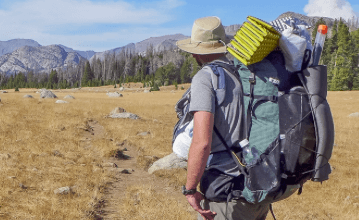
When we talk about how easy it is to pack one of the best foam sleeping pads in or on your pack, the two main things to consider are overall packed dimensions and weight.
Most foam sleeping pads are either rolled up when not in use or folded in a Z-formation. They can be strapped to the top, bottom, or sides of your pack, depending on your preference. Some even roll or fold up small enough to fit inside your pack, depending on the dimensions of your pack.
The first decision you’ll want to make is whether you want to secure one of the best foam sleeping pads to the exterior of your pack or store it inside. If you choose the latter, you’re going to want to go with the smallest packed dimensions you can find so that you have plenty of room for food, water, a sleeping bag, and other hiking essentials. If you plan to store the pad on the exterior of your pack, you’ll be able to work with larger packed dimensions.
The next decision you’ll have to make is about weight. How much weight are you willing to tolerate in a sleeping pad? Many ultralight backpackers weigh out their gear down to the ounce, and too much extra weight can take a toll on your body when traveling 30+ miles every day for six months straight. But, if you’re only going to use one of the best foam sleeping pads for weekend car camping getaways, you’ll probably never even notice those extra four ounces.
Comfort
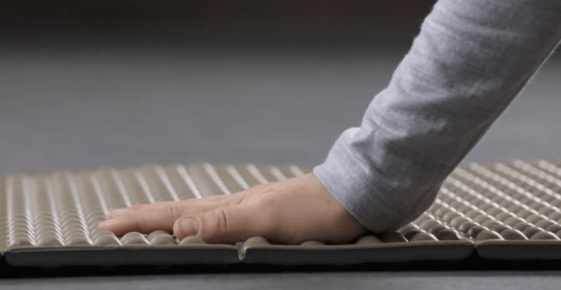
For me, comfort is everything. If I can get a great night’s rest while backpacking and camping, then I’m relaxed and ready to handle almost anything the next day can throw at me. So, for my money, I like to have that extra layer of cushioning to make sure no rocks or roots are jabbing into my back or sides throughout the night.
When it comes to the best foam sleeping pads, the general rule is that a thicker pad will be a more comfortable pad. It’s not rocket science here guys! A thicker pad means more cushion from those bothersome roots and rocks, and it also means more insulation from the cold. Getting too cold in the middle of the night is a surefire way to get a less-than-stellar night’s sleep!
What Is Your Experience With the Best Foam Sleeping Pads?
So there you have it! I hope you’ve enjoyed this summary of my top picks for the best foam sleeping pads and I’d love to hear your feedback in the comments section below. I’ll be quick to reply to any questions, comments, or concerns you feel like sharing.
If you decide to purchase one of the best foam sleeping pads after reading this article, I’d love to hear about your experience once you’ve taken one of the best foam sleeping pads out for a few trips!
I receive a commission for any product you purchase by clicking the links I provide on this site. As an affiliate marketer, I have relationships with many of the leading brands in the outdoor industry.
Everything I earn through this site helps me continue to create more helpful resources, which will one day include guided backpacking trips!
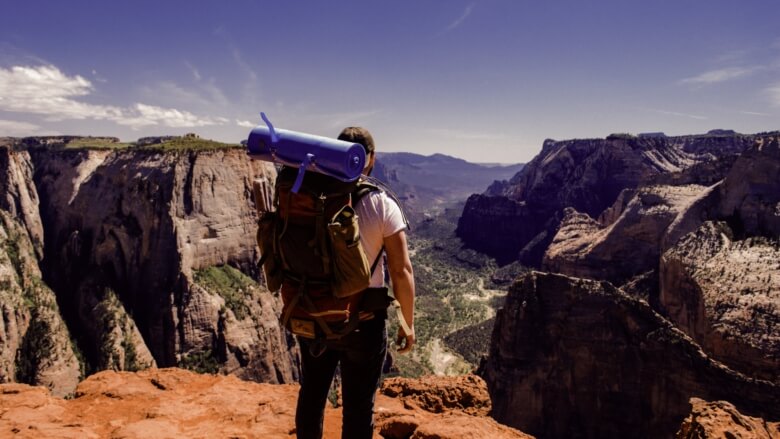
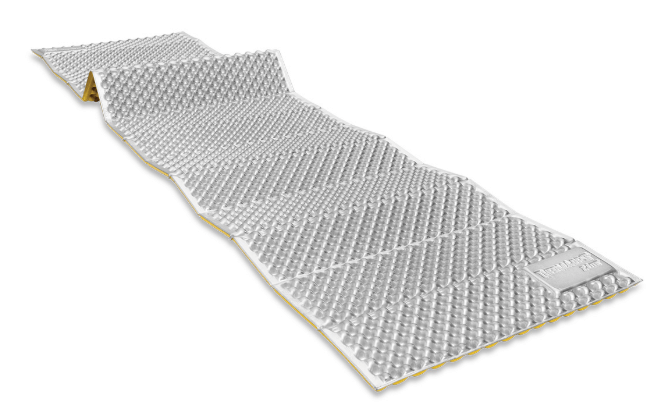
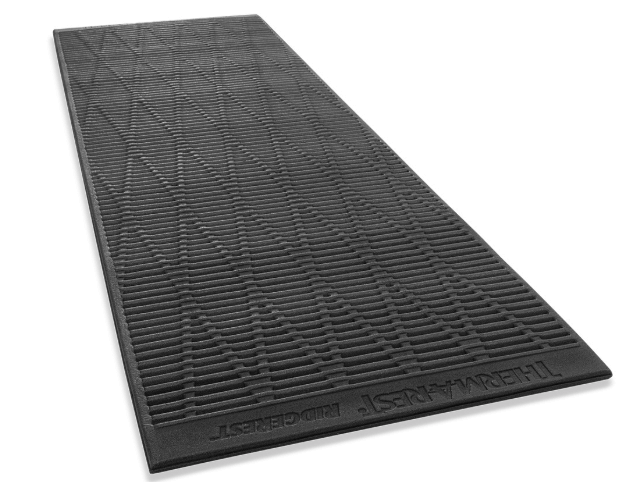
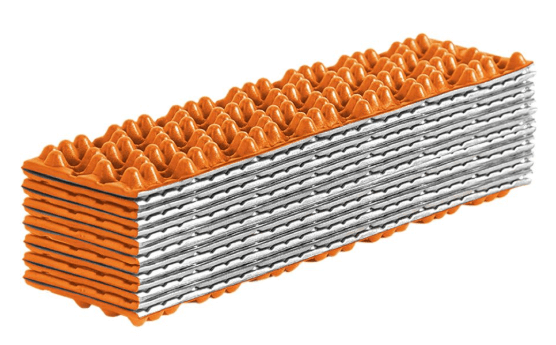
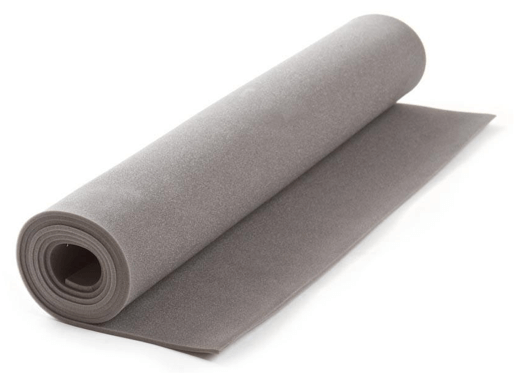
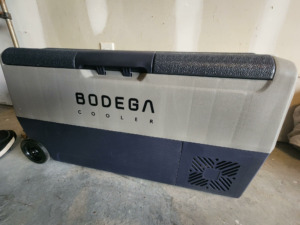

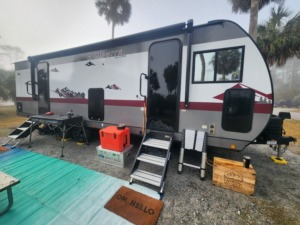
Comments
Great article about sleeping pads. I like the NEMO Switchback the best. We are actually looking at going camping in a few weeks. What is the delivery time on these?
The reason I liked that one is because it seems to offer the sport my husband would need for his back. He has back issues, it seems this pad would be most beneficial to him. Will weight change how much sleep a person can get?
Author
In general, the heavier the individual the more padding you’ll want for a comfortable night’s sleep. NEMO has free 2-day shipping on orders over $50. Check out the link and let me know how you like it if you grab one!
This is an awesome post! I have spent a lot of time hiking/camping and am always looking for more efficient equipment thats lightweight and durable. I like the Thinlight the best because I try to be minimalist as possible with my packing and this works perfect for me! I’ll also be checking out your Youtube Channel. Thanks for Sharing!
Author
You’re very welcome! Please feel free to let me know if there are any products you’d like to see me review, either on this site or on my YouTube channel!
Not something to see everyday. I am planning a camp this summer and I am trying to gather some new equipment to take along, what I noticed is that not so many people talk about the sleeping pads. Having read your post, I think I’ll go for the switch back. My camp is still a long way but I’ll be sure to come back here with my feedback. Thanks for the info.
Author
I’d love to hear your feedback! And yes, in my opinion, sleeping pads are very underrated and they have a huge impact on your ability to get a solid night’s sleep in the wilderness!
I couldn’t have been more annoyed when my inflated camping bed got deflated and I hit the stones hard with my elbow. So, I have decided to calk it a quit and I actually go for the foam sleeping pads atleast, they would be easier to pack and add up to the camping backpack. I already got a suggestion from a friend and when I saw his suggested foam pad, Ridgerest, listed on this post and being reviewed, then I decided ive gotten the one I will buy. Thanks for the overview on the best foam pads
Author
You’re very welcome! I’d love to hear about your experience with your new pad once you’ve gotten it out on a few trips!
My discussion on the topic would be this is so much better than a blow up mattress even a small one. Its light and easy to carry but comfort is everything! Good experiences with some these as they are inexpensive and last for a long time! Nemo Equipment has given me the best experience comfort wise! Great topic as everyone should enjoy the out doors comfortably 🙂
Author
Thanks so much for sharing your experience! I know that the blow up mattresses can sometimes offer more cushion (initially), but I’ve had too many bad experiences with that type of mattress either being punctured or slowly deflating throughout the course of the night that I pretty much exclusively trust foam sleeping pads at this point.